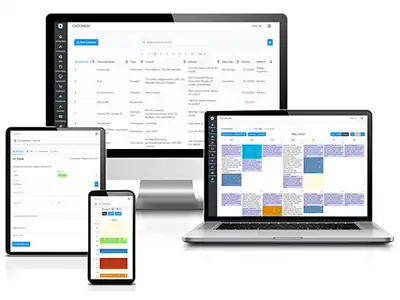
Field service operations are key to delivering exceptional service and ensuring customer satisfaction. However, for small businesses, especially those with limited resources, efficiently managing field service operations can be challenging. This is where field service metrics come into play, helping businesses measure success, streamline operations, and identify areas for improvement.
In this article, we’ll dive into the essential metrics small businesses should track to excel in the field service industry.
Why Metrics Matter in Field Service for Small Businesses
Metrics play a crucial role in modern business management. By quantifying performance, they offer objective insights that allow small business owners to make informed decisions. In the field service industry, metrics help monitor technician performance, customer satisfaction, and operational efficiency. For small businesses that can’t afford inefficiencies, tracking metrics becomes essential for staying competitive. When you measure the right data points, you gain the knowledge needed to optimize service quality, allocate resources effectively, and boost profitability.
Understanding Key Performance Indicators (KPIs) for Field Service
What Are KPIs?
Key Performance Indicators (KPIs) are specific, measurable values that showcase how effectively a business is achieving its objectives. They provide benchmarks for performance and offer a snapshot of operational health. For field service, KPIs measure a wide range of activities—from customer satisfaction to technician efficiency—helping business owners stay aligned with their strategic goals.
How KPIs Drive Business Success
KPIs are essential for assessing progress and highlighting areas for improvement. For small businesses in the field service industry, KPIs enable smarter planning and more efficient operations. By focusing on critical KPIs, such as response time and customer satisfaction, businesses can prioritize actions that drive growth, improve service quality, and reduce costs. When used consistently, KPIs empower teams to focus on what matters most, helping small businesses thrive in competitive markets.

Customer Satisfaction Metrics
Importance of Customer Feedback
Customer feedback provides invaluable insights into the customer’s experience, revealing what aspects of service need improvement. Small businesses rely on customer loyalty, making it crucial to understand and respond to customer needs. By actively gathering and analyzing feedback, businesses can identify patterns in satisfaction and make necessary adjustments.
Customer Retention Rate
Customer retention rate measures the percentage of clients who continue using a service over time. For field service businesses, a high retention rate indicates customer loyalty and satisfaction, while a low rate may suggest a need to improve service quality.
Retaining customers is often more cost-effective than acquiring new ones, making this metric essential for sustainable growth. Utilizing CRM software can significantly help businesses tackle this issue.
Customer Effort Score (CES)
The Customer Effort Score measures how easy it is for customers to resolve their issues or complete a service request. Unlike other satisfaction metrics, CES focuses on minimizing the effort customers need to make, which can greatly influence their perception of the business. A low effort score is linked to higher satisfaction and loyalty, making CES a vital metric for field service providers.
Response and Resolution Time
Initial Response Time
Initial response time refers to the amount of time it takes for a business to respond to a customer’s service request. In the field service industry, fast response times are crucial as they convey a sense of urgency and commitment to resolving issues. Small businesses that can quickly respond to customer needs often enjoy higher satisfaction and loyalty levels.
Average Resolution Time
Resolution time measures how long it takes to resolve an issue once it’s been reported. This metric is key to understanding efficiency in handling service requests. A shorter resolution time often leads to higher customer satisfaction and can set a small business apart from its competitors. Tracking this metric allows businesses to improve their processes and ensure timely solutions for customers.
Technician Performance Metrics
First-Time Fix Rate
First-Time Fix Rate (FTFR) is the percentage of service calls where the technician resolves the issue on their first visit. This metric is a strong indicator of technician skill and preparedness. A high FTFR reduces costs associated with repeat visits and boosts customer satisfaction, as problems are resolved quickly. For small businesses, optimizing FTFR can lead to significant cost savings and operational efficiency.
Technician Utilization
Technician utilization measures how effectively a technician’s time is used for productive work. High utilization rates indicate that technicians spend more time addressing customer needs rather than being idle or bogged down with administrative tasks. Efficient use of technicians time directly impacts profitability, making utilization a critical metric for small businesses aiming to make the most out of limited resources.

Schedule Adherence and Punctuality
Importance of Punctuality in Field Service
For field service providers, punctuality is crucial as it reflects reliability and respect for customers’ time. A late arrival can inconvenience clients and damage a business’s reputation. Small businesses need to ensure that their technicians arrive on time, as this creates a positive first impression and builds trust with clients. Implementing scheduling software can help get organized.
Measuring Schedule Adherence
Schedule adherence tracks whether technicians arrive on time for appointments. By monitoring adherence, businesses can pinpoint scheduling issues or operational bottlenecks. Improving schedule adherence can lead to higher customer satisfaction, as clients appreciate prompt and reliable service. For small businesses, adhering to schedules also helps manage workloads and optimize technician availability.
Cost Metrics for Field Service Management
Cost Per Job
Cost per job calculates the average expense incurred to complete a service request, including labor, parts, and travel costs. This metric is essential for understanding job profitability. By tracking costs, small businesses can identify areas where expenses can be reduced without compromising service quality, improving overall profitability.
Travel Time and Expense Tracking
Field service often involves travel, and these expenses can accumulate quickly. Tracking travel time and related expenses helps businesses manage costs and identify inefficiencies. By analyzing travel data, small businesses can optimize routes, reduce fuel expenses, and minimize time spent on the road, all of which contribute to cost savings and improved efficiency.
Work Order Metrics
Work Order Completion Rate
The work order completion rate measures the percentage of work orders completed within a given time frame. This metric helps small businesses assess technician productivity and the effectiveness of their processes. A high completion rate suggests efficient workflows, while a low rate may indicate issues such as insufficient resources or scheduling problems.
Utilization of a work order system can help streamline this process.
Average Job Duration
The average job duration tracks the time taken to complete a standard job. By understanding the typical job length, businesses can better plan schedules, allocate resources, and manage customer expectations. If jobs consistently take longer than expected, it may signal a need for additional training or adjustments in workflow.
Inventory and Asset Management Metrics
Stockout Rate
The stockout rate measures the frequency of running out of essential inventory items. For small businesses, running out of parts or supplies can lead to service delays, reduced efficiency, and unhappy customers. By tracking this metric, companies can ensure they maintain appropriate stock levels, preventing costly downtime.
Asset Utilization
Utilization of assets examines how often tools, equipment, and vehicles are used in field service. High utilization suggests that resources are effectively managed, while low utilization may indicate underuse or inefficiency. Small businesses benefit from tracking this metric, as it helps them maximize the value of their assets.
Revenue and Profitability Metrics
Revenue per Technician
Revenue per tech measures the income generated by each technician, providing insights into their performance and the business’s overall profitability. For small businesses, this metric highlights the effectiveness of their workforce and helps identify high-performing technicians.
Gross Profit Margin per Job
Per job gross profit margin calculates the profitability of each service request. This metric provides clarity on which services are most lucrative and helps small businesses make strategic decisions on pricing, resource allocation, and job prioritization.
Employee Satisfaction and Retention
Technician Satisfaction
Productivity and service quality can be significantly impacted by technicians. Satisfied technicians are more likely to be engaged, perform well, and stay with the company. Small businesses can gauge satisfaction through surveys, informal feedback, and tracking turnover rates, fostering a positive work environment that promotes loyalty and productivity.
Turnover Rate
Turnover rate indicates the frequency at which employees leave the business. High turnover can lead to increased hiring costs, training time, and a loss of experienced workers. Monitoring turnover rates helps small businesses retain valuable talent, reducing costs associated with recruiting and training new employees.
Using Technology to Track Field Service Metrics
Benefits of Field Service Management Software
Field Service Management software (FSM) simplifies metric tracking by automating data collection and analysis. For small businesses, FSM tools can reduce administrative tasks, improve scheduling accuracy, and enhance resource allocation. Software also allows for real-time data tracking, enabling quick responses to changing conditions.
Integrating Metrics into Business Decisions
Collecting data is only valuable if it drives actionable insights. Small businesses must analyze metrics and integrate them into decision-making processes to improve efficiency, customer satisfaction, and cost-effectiveness. By using metrics as a foundation, businesses can make strategic choices that align with their goals and growth objectives.
Implementing a Metrics-Driven Approach
A metrics-driven approach involves setting clear objectives, establishing KPIs, and committing to regular reviews. For small businesses, this means identifying the most relevant metrics and using technology to track them efficiently. By adopting a metrics-driven approach, businesses can achieve higher levels of service quality, enhance customer satisfaction, and make informed choices that drive growth.
Conclusion
Field service metrics empower small businesses to operate more efficiently, improve customer satisfaction, and maximize profitability. From technician performance to customer satisfaction, each metric provides valuable insights into different aspects of the business. By tracking these metrics, small businesses can make smarter decisions, reduce costs, and position themselves for long-term success in the competitive field service industry.
FAQs
What is a good First-Time Fix Rate for small businesses? A good FTFR is generally around 70-75%. However, this can vary depending on the industry, type of service, and complexity of work.
How can I reduce travel costs in field service? Reducing travel costs can be achieved by optimizing routes, consolidating service calls, and using local technicians when possible.
Why is technician utilization important? Technician utilization measures productive work time, which directly impacts profitability. It helps maximize output from available resources.
How often should I review my field service metrics? Reviewing metrics monthly is common, but for dynamic environments, weekly or bi-weekly reviews can help catch issues sooner.
